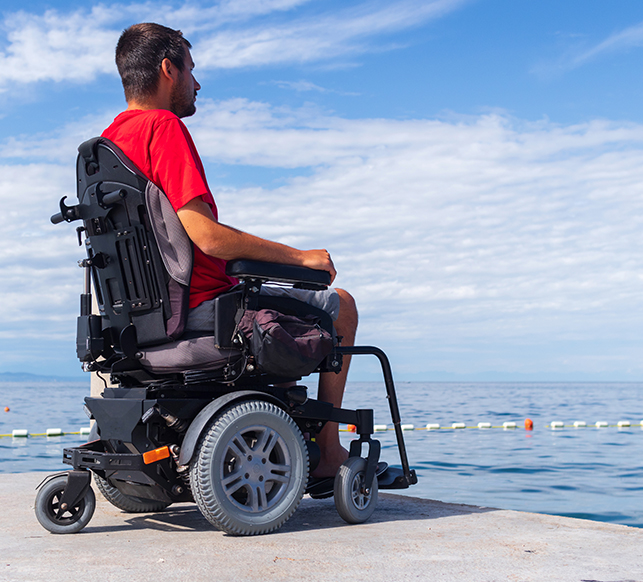Muscular Dystrophy

Our focus is to help you live an independent life in the comfort of your own home
Types of muscular dystrophy
Duchenne muscular dystrophy
This type of MD mostly affects young children, and particularly boys. This is a severe type of MD and there are many different symptoms associated with this disease, including walking difficulties, thinning of the bones, and some sufferers may also end up with poor posture. This disease can also cause a loss of reflexes, difficulties with breathing and weakening of the lung and heart. An abnormal curve in the spine is also a known symptom of Duchenne muscular dystrophy. As it is a progressive disease, it often worsens to the point where the sufferer needs to use a wheelchair before they reach their teenage years. The life expectancy is short for those with this disease, often only living until their 20’s.
Becker muscular dystrophy
The symptoms of Becker muscular dystrophy are similar to Duchenne muscular dystrophy, however they are usually not as severe. The typical symptoms include muscle craps, and falling over. Individuals with this disease may also find that they walk on their toes. Symptoms often don’t develop until teenage years but they may also occur a lot later in mid twenties. The weakening of muscles is usually confined to the arms and legs. Unlike Duchenne muscular dystrophy, sufferers of Becker muscular dystrophy have a much longer lifespan, often living until middle age or older. A wheelchair might never be required, or it may be required a lot later in life.
Congenital muscular dystrophy
The symptoms of this disease usually show early, either at birth or up to around 2 years’ of age. Parents often start to notice that their child isn’t developing in the way they would expect, particularly muscles and motor functions. There are a wide range of symptoms of this disease, including muscle weakness, difficulties with swallowing and breathing, scoliosis. Other severe symptoms including the inability to speak properly and vision problems. Foot deformities are also relatively common. In severe cases, people with this disease need help with basic functions, such as sitting or standing. It is difficult to determine the life expectancy of a person with Congenital muscular dystrophy. However, some individuals live until adulthood.
Myotonic dystrophy
Often referred to as Steinert’s disease, this causes myotonia, which means the sufferer of the disease cannot relax their muscles. Symptoms of this disease include, a weakening of the facial muscles, resulting in an older looking appearance. Neck muscles may become worn, making it difficult to lift the neck. Poor vision and increased sweating are other common symptoms. The areas Myotonic dystrophy affects are the facial muscles, thyroid, eyes, adrenal glands, as well as central nervous system. It usually appears in people over the age of 20, and some may only have mild symptoms, while others will experience more intense, life-threatening symptoms.
Facioscapulohumeral muscular dystrophy
Also referred to as FSHD, this muscular dystrophy causes a variety of symptoms that may include, issues with chewing and swallowing, shoulders that appear slanted and a crooked mouth. Hearing and respiratory problems also affect some individuals with the disease. It is a progressive disease, but the progress is often relatively slow. It can affect anyone at any age, from teenage to 40’s. This is one of the less severe types, and it is common for people with FSHD to have a regular lifespan.
Limb-girdle muscular dystrophy
This type of muscular dystrophy tends to affect people at an early age, often leading to full disability by age 20. It tends to affect both males and females, but individuals with this disease usually have a normal life expectancy. The symptoms of the disease are a weakening of muscles, and it can cause difficulty in moving in a normal way. It can be difficult to balance, and many sufferers of this disease fall more easily.
Oculopharyngeal muscular dystrophy
This type of muscular dystrophy is most common in later life, from 40’s to 50’s and it affects both males and females. The symptoms are variable, and include, difficulties with swallowing, changes in the voice, drooping eyelids, heart and vision problems.
Distal muscular dystrophy
Another name for Distal muscular dystrophy is distal myopathy and this affects a variety of muscles including those in the calves, feet, hands and forearms. Respiratory problems can also develop, as well as problems with the heart muscles. This disease tends to progress quite slowly, and it is often not diagnosed until between the ages of 40 and 60.
Emery-dreifuss muscular dystrophy
Most commonly found in males, this type of muscular dystrophy usually starts from a very early age. Some of the symptoms are, a weakness in the arm or leg muscles, problems with breathing and heart issues. This is a severe form of muscular dystrophy and often leads to death in early to mid adulthood, usually as a consequence of the heart or lung failing.
Diagonising muscular dystrophy
In order to determine whether you have muscular dystrophy, and indeed, what type you have, the doctor would usually undertake some blood tests to find out the enzymes being released by damaged muscles and genetic markers. An electromyography and muscle biopsy are also usually undertaken to check for signs of the disease. There is no cure for the disease, however, medication and surgery can be issued for certain problems caused by muscular dystrophy, and in some cases, Homecare services may be required.
Helping you live a fulfilling life with muscular dystrophy
As there are many different types of muscular dystrophy, it is even more important that we develop a care package that is completely tailored to suit your own needs, or that of your family member or friend, suffering from the disease. We want to ensure that anyone with muscular dystrophy can live well in the comfort of their own home, while getting the help and support they need, when they need it. We focus on helping you to enjoy life, in whatever capacity that may be, and our carers will always actively encourage you to get involved in new activities, as well as those you already enjoy.


Some of the services our carers offer, include:
- Support with walking, as required, including activities such as shopping, visiting family and friends, etc.
- Help with personal care and feeding.
- Administering medication and preparing meals
We will adapt to suit the level of service you require. For instance, if you are caring for a child with muscular dystrophy, our carers can provide respite care when needed, as well as overnight care and emergency care. We offer a flexible approach, ensuring the needs of our clients are always catered for, no matter what they may be.
Case study for child with muscular dystrophy
Amy is 6 years’ old and has recently been diagnosed with congenital muscular dystrophy. Although she is still able to walk and play, she does so with difficulty, often falling over, and sometimes hurting herself. Her parents both work full time and Amy goes to school. Amy needs to be watched 24/7, and with the summer holidays approaching, her parents have made the decision that they need the help of a carer while they are working during the summer. They called upon us to provide a carer. Our first step was to assess Amy and the level of care she needed, which was nurse-led. The registered nurse then devised a plan, instructing the carer of what would be required of them to ensure Amy’s safety and happiness. The carer provided short term care throughout the summer holidays, focusing on ensuring Amy received round-the-clock care for her safety, as well as enjoying activities with her and letting her spend time with friends. As always, the priority for our carers was to ensure Amy’s safety, while also helping her to be independent and to enjoy her summer break. Her parents were able to go to work, safe in the knowledge that their daughter was in safe hands.
Case study for adult with muscular dystrophy
Gerry is 50 years old and lives with emery-dreifuss muscular dystrophy. He is confined to a wheelchair and has extreme breathing difficulties. Gerry required complex care, which became impossible for friends or family to provide. Gerry’s main worry was that he would end up losing his independence, as a result of using carers. We spoke to Gerry and his family about the type of care he wanted and needed, and as round-the-clock care was essential, we provided a team of carers selected based on Gerry’s personality and their expertise. As well as the complex care provided for his respiratory issues, the team of carers work on a rotational basis to cater for his other needs, including feeding, personal care and shopping. Gerry still gets out and about with the help of the carer, and they also ensure they give him time on his own to watch TV, read etc. Gerry has peace of mind that he is safe, and has his needs tended to, while not feeling like a burden. He likes the fact that he has also retained his independence and he never feels that the carers are under his feet.